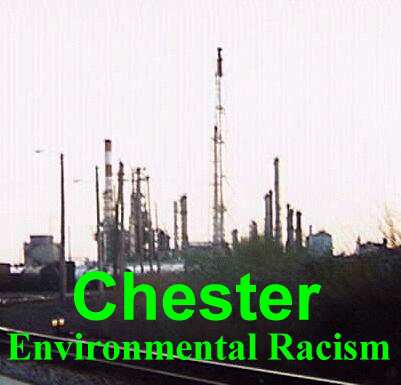Environmental Racism in Chester, Pennsylvania
Delco Alliance for Environmental Justice
[ HOME PAGE ] [ NETWORK ] [ 3 DAYS of ACTION ]
contact us
Presentations & Reports:
- Environmental Injustice in Delaware County, PA (Feb 2008 presentation by Mike Ewall of ActionPA) [Powerpoint version]
- Mapping Environmental Justice in Delaware County, PA (Spring 2006 report by Swarthmore College students)
- Chester, Pennsylvania Risk Study (presentation by Reginald Harris of EPA) [Powerpoint version]
- Delaware County Solid Waste Management Plan (17 MB)
Updates:
- 2007: Stoney Creek Chemical Plant Violations
- 2003: New Waste Facility Targets Chester! — Stop Clean Metal! (plant shut down after operating without a permit for about two years)
- 1998: 10/6 – Supreme Court Declares Chester Lawsuit Moot
- 1998: 6/10 – Philadelphia signs contract to send waste to Chester (see action alert here)
- 1998: 6/9 – U.S. Supreme Court to Hear Environmental Racism Suit vs. PA DEP
- 1998: 6/4 – Ogborne Construction/Demolition Waste Transfer Station Defeated!
- 1998: 2/19 – George Magazine names Chester one of “the 10 most corrupt cities in America”
- 1997: 12/31 – Federal Court Gives Green Light to Environmental Racism suit against PA DEP
- 1997: 12/18 – Chester Residents win settlement with DELCORA sludge incinerator
- 1997: 11/7 – Victory over Cherokee Biotechnology
- 1997: 5/2 – Chester Update: Racist Firings at American Ref-Fuel Incinerator
- 1996: 5/29 – Environmental Racism Lawsuit Filed

- Chester has the highest percentage of low-weight births in the
state, and has mortality rate and lung cancer rates that are 60%
higher than the rest of Delaware County. - Noise and vibration from the constant stream of trucks carrying
infectious waste and garbage have caused the foundations of
houses in Chester to crack. These trucks (at a rate of up to one
truck every 4.5 minutes) travel the same roads that the children
of Chester play in because they have no where else to go. - Blood-lead levels among the children of Chester are higher than
anywhere else in Pennsylvania.
Chester, PA, a 65% African-American, low-income community
Southwest of Philadelphia is home to four hazardous and municipal
waste facilities. The nation’s 7th largest trash (and industrial waste) incinerator, the nation’s largest medical waste autoclave (closed since 1995), and a sewage treatment plant and sludge incinerator
are all cited only yards from the houses
of Chester. The EPA has found that blood lead-levels in
Chester’s children are “unacceptably high,” that “air emissions
from facilities in and around Chester provide a large component
of the cancer and non-cancer risks to the citizens of Chester,”
and that “both cancer and non-cancer risks, e.g. kidney and liver
disease and respiratory problems, from the pollution sources at
locations in the city of Chester exceed levels which EPA believes
are acceptable.”
Chester Residents Concerned for Quality Living was a local
grassroots community organization that fought for
environmental justice in Chester from 1992 through 2001. Their
non-violent approach to combating the situation has been met with
harassment and intimidation by the people who own and operate the
facilities in Chester. Their office has been broken into and
vandalized with racist symbols and slogans, their tires have been
slashed, peaceful protesters have been run over by garbage trucks,
and they have had other residents turn against them.
Despite this intimidation, under Zulene Mayfield’s leadership, they stood strong and won many victories. Now, with the new formation of the Delco Alliance for Environmental Justice in 2007, the community is getting reorganized to face the new wave of industrial threats.
<!–
The situation in Chester is worsening now due to inaction on the
part of the agencies that are supposed to protect Chester’s
residents. Use the information here to get in touch and get involved with
helping the people of Chester and all of us who suffer indirectly from the
pollution in Chester. –>
<!–
Local/Regional Chester Support Groups:
–>
http://www.ejnet.org/chester/

 Where Chester City is …
Where Chester City is … Brief History of Chester
Brief History of Chester Health Effects and Demographics
Health Effects and Demographics